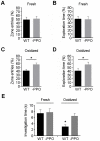Improvement of aroma in transgenic potato as a consequence of impairing tuber browning
- PMID: 21103333
- PMCID: PMC2984436
- DOI: 10.1371/journal.pone.0014030
Improvement of aroma in transgenic potato as a consequence of impairing tuber browning
Abstract
Sensory analysis studies are critical in the development of quality enhanced crops, and may be an important component in the public acceptance of genetically modified foods. It has recently been established that odor preferences are shared between humans and mice, suggesting that odor exploration behavior in mice may be used to predict the effect of odors in humans. We have previously found that mice fed diets supplemented with engineered nonbrowning potatoes (-PPO) consumed more potato than mice fed diets supplemented with wild-type potatoes (WT). This prompted us to explore a possible role of potato odor in mice preference for nonbrowning potatoes. Taking advantage of two well established neuroscience paradigms, the "open field test" and the "nose-poking preference test", we performed experiments where mice exploration behavior was monitored in preference assays on the basis of olfaction alone. No obvious preference was observed towards -PPO or WT lines when fresh potato samples were tested. However, when oxidized samples were tested, mice consistently investigated -PPO potatoes more times and for longer periods than WT potatoes. Congruently, humans discriminated WT from -PPO samples with a considerably better performance when oxidized samples were tested than when fresh samples were tested in blind olfactory experiments. Notably, even though participants ranked all samples with an intermediate level of pleasantness, there was a general consensus that the -PPO samples had a more intense odor and also evoked the sense-impression of a familiar vegetable more often than the WT samples. Taken together, these findings suggest that our previous observations might be influenced, at least in part, by differential odors that are accentuated among the lines once oxidative deterioration takes place. Additionally, our results suggest that nonbrowning potatoes, in addition to their extended shelf life, maintain their odor quality for longer periods of time than WT potatoes. To our knowledge this is the first report on the use of an animal model applied to the sensory analysis of a transgenic crop.
Conflict of interest statement
Figures




References
Publication types
MeSH terms
Substances
LinkOut - more resources
Full Text Sources

